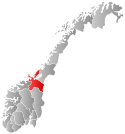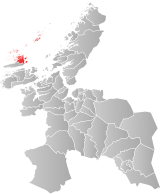Nord-Frøya Municipality
Nord-Frøya Municipality
Nord-Frøya herred | |
|---|---|
| Nordfrøya herred (historic name) | |
 Sør-Trøndelag within Norway | |
 Nord-Frøya within Sør-Trøndelag | |
| Coordinates: 63°47′44″N 08°48′28″E / 63.79556°N 8.80778°E | |
| Country | Norway |
| County | Sør-Trøndelag |
| District | Fosen |
| Established | 1 Jan 1906 |
| • Preceded by | Frøien Municipality |
| Disestablished | 1 Jan 1964 |
| • Succeeded by | Frøya Municipality |
| Administrative centre | Svellingen |
| Government | |
| • Mayor (1960–1963) | Oskar Steinvik (Ap) |
| Area (upon dissolution) | |
• Total | 138.6 km2 (53.5 sq mi) |
| • Rank | #450 in Norway |
| Highest elevation | 75 m (246 ft) |
| Population (1963) | |
• Total | 4,362 |
| • Rank | #202 in Norway |
| • Density | 31.5/km2 (82/sq mi) |
| • Change (10 years) | |
| Demonym | Nord-Frøyværing[2] |
| Official language | |
| • Norwegian form | Neutral[3] |
| Time zone | UTC+01:00 (CET) |
| • Summer (DST) | UTC+02:00 (CEST) |
| ISO 3166 code | NO-1620[5] |
Nord-Frøya is a former municipality in the old Sør-Trøndelag county, Norway. The 139-square-kilometre (54 sq mi) municipality existed from 1906 until its dissolution in 1964. Nord-Frøya Municipality included the northern part of the island of Frøya and all of the small islands to the north and northeast such as Sula, Mausund, Froan, and Halten in what is now Frøya Municipality in Trøndelag county. The main church for the municipality was Nord-Frøya Church (now called Sletta Church) which is located at Svellingen (the administrative centre of the municipality) on the northern coast of the island.[6]
Prior to its dissolution in 1964, the 138.6-square-kilometre (53.5 sq mi) municipality was the 450th largest by area out of the 689 municipalities in Norway. Nord-Frøya Municipality was the 202nd most populous municipality in Norway with a population of about 4,362. The municipality's population density was 31.5 inhabitants per square kilometre (82/sq mi) and its population had decreased by 1.7% over the previous 10-year period.[7][8]
General information
[edit]
The municipality was established on 1 January 1906 when the old Frøien Municipality was divided into two new municipalities: Sør-Frøya Municipality in the south (population: 2,091) and Nord-Frøya Municipality in the north (population: 3,972). During the 1960s, there were many municipal mergers across Norway due to the work of the Schei Committee. On 1 January 1964, Sør-Frøya Municipality (population: 2,208) and Nord-Frøya Municipality (population: 4,348) were merged (back together) to form the new Frøya Municipality.[9]
Name
[edit]The municipality is named after the island of Frøya. The prefix nord means "northern", literally meaning the northern part of Frøya. The second part of the name comes from Norse mythology. Although Frøya is a variant of the name of the Norse goddess Freyja, the Old Norse form of the name of the island was Frøy or Frey (the ending -a in the modern form is actually the definite article - so the meaning of Frøya is 'the Frøy'). Therefore, the name of the island probably has the same root as the name of the Norse god Freyr, brother to Freyja. The names originally were titles: "lord" or "lady". The oldest meaning of the common word was "(the one) in front; the foremost, the leading" and here in the sense "the island in front of Hitra". Until 1906, the name of the island and predecessor municipality was spelled Frøien (-en is the definite article in Danish-Norwegian).[10] When this new municipality was established in 1906, the name of the municipality was spelled Nordfrøya. On 3 November 1917, a royal resolution changed the spelling of the name of the municipality to Nord-Frøya.[11]
Churches
[edit]The Church of Norway had one parish (sokn) within Nord-Frøya Municipality. At the time of the municipal dissolution, it was part of the Frøya prestegjeld and the Sør-Fosen prosti (deanery) in the Diocese of Nidaros.[8]
| Parish (sokn) | Church name | Location of the church | Year built |
|---|---|---|---|
| Nord-Frøya | Nord-Frøya Church | Sletta (just east of Svellingen) | 1880 |
| Froan Chapel | Froan | 1904 | |
| Måøy Chapel | Mausund | 1939 | |
| Sula Chapel | Sula | 1925 |
Geography
[edit]The municipality was primarily located on the northern part of the island of Frøya along with many smaller islands and islets. The highest point in the municipality was the 75-metre (246 ft) tall mountain Besselvassheia, on the border with Sør-Frøya Municipality.[1] The municipality was bordered by Sør-Frøya Municipality to the south.
Government
[edit]While it existed, Nord-Frøya Municipality was responsible for primary education (through 10th grade), outpatient health services, senior citizen services, welfare and other social services, zoning, economic development, and municipal roads and utilities. The municipality was governed by a municipal council of directly elected representatives. The mayor was indirectly elected by a vote of the municipal council.[12] The municipality was under the jurisdiction of the Frostating Court of Appeal.
Municipal council
[edit]The municipal council (Herredsstyre) of Nord-Frøya was made up of 29 representatives that were elected to four year terms. The tables below show the historical composition of the council by political party.
| Party name (in Norwegian) | Number of representatives | |
|---|---|---|
| Labour Party (Arbeiderpartiet) | 15 | |
| Conservative Party (Høyre) | 4 | |
| Christian Democratic Party (Kristelig Folkeparti) | 5 | |
| Liberal Party (Venstre) | 5 | |
| Total number of members: | 29 | |
| Party name (in Norwegian) | Number of representatives | |
|---|---|---|
| Labour Party (Arbeiderpartiet) | 14 | |
| Conservative Party (Høyre) | 3 | |
| Christian Democratic Party (Kristelig Folkeparti) | 5 | |
| Liberal Party (Venstre) | 7 | |
| Total number of members: | 29 | |
| Party name (in Norwegian) | Number of representatives | |
|---|---|---|
| Labour Party (Arbeiderpartiet) | 9 | |
| Conservative Party (Høyre) | 2 | |
| Christian Democratic Party (Kristelig Folkeparti) | 3 | |
| Liberal Party (Venstre) | 5 | |
| Local List(s) (Lokale lister) | 1 | |
| Total number of members: | 20 | |
| Party name (in Norwegian) | Number of representatives | |
|---|---|---|
| Labour Party (Arbeiderpartiet) | 6 | |
| Conservative Party (Høyre) | 3 | |
| Christian Democratic Party (Kristelig Folkeparti) | 4 | |
| Liberal Party (Venstre) | 7 | |
| Total number of members: | 20 | |
| Party name (in Norwegian) | Number of representatives | |
|---|---|---|
| Labour Party (Arbeiderpartiet) | 9 | |
| Conservative Party (Høyre) | 1 | |
| Christian Democratic Party (Kristelig Folkeparti) | 3 | |
| Liberal Party (Venstre) | 6 | |
| Local List(s) (Lokale lister) | 1 | |
| Total number of members: | 20 | |
| Party name (in Norwegian) | Number of representatives | |
|---|---|---|
| Labour Party (Arbeiderpartiet) | 8 | |
| Liberal Party (Venstre) | 8 | |
| Joint list of the Conservative Party (Høyre) and the Free-minded People's Party (Frisinnede Folkeparti) | 4 | |
| Total number of members: | 20 | |
| Note: Due to the German occupation of Norway during World War II, no elections were held for new municipal councils until after the war ended in 1945. | ||
Mayors
[edit]The mayor (Norwegian: ordfører) of Nord-Frøya was the political leader of the municipality and the chairperson of the municipal council. Here is a list of people who held this position:[19]
- 1906–1907: Martin Sivertsen (V)
- 1908–1910: Berntinus Dragsnæss (H)
- 1911–1911: John Lorntsen Uttian (V)
- 1912–1913: Jacob Meland
- 1914–1916: Lorentz Fredagsvik (V)
- 1917–1922: Andreas O. Eidsvaag (V)
- 1923–1925: Ole Aukan (H)
- 1926–1928: Andreas O. Eidsvaag (V)
- 1929–1934: John Lorntsen Uttian (V)
- 1935–1937: Ole Aukan (H)
- 1938–1940: Andreas O. Eidsvaag (V)
- 1940–1944: Bengt J. Tørum (NS)
- 1944–1945: Einar Meland (NS)
- 1945–1945: Andreas O. Eidsvaag (V)
- 1946–1951: Kristian Hammer (V)
- 1952–1955: Oskar Steinvik (Ap)
- 1956–1959: Gunnar Halset (V)
- 1960–1963: Oskar Steinvik (Ap)
See also
[edit]References
[edit]- ^ a b "Høgaste fjelltopp i kvar kommune" (in Norwegian). Kartverket. 16 January 2024.
- ^ "Navn på steder og personer: Innbyggjarnamn" (in Norwegian). Språkrådet.
- ^ "Norsk Lovtidende. 2den Afdeling. 1932. Samling af Love, Resolutioner m.m". Norsk Lovtidend (in Norwegian). Oslo, Norway: Grøndahl og Søns Boktrykkeri: 453–471. 1932.
- ^ "Forskrift om målvedtak i kommunar og fylkeskommunar" (in Norwegian). Lovdata.no.
- ^ Bolstad, Erik; Thorsnæs, Geir, eds. (9 January 2024). "Kommunenummer". Store norske leksikon (in Norwegian). Foreningen Store norske leksikon.
- ^ Thorsnæs, Geir, ed. (26 November 2024). "Nord-Frøya". Store norske leksikon (in Norwegian). Foreningen Store norske leksikon. Retrieved 23 January 2025.
- ^ Statistisk sentralbyrå. "Table: 06913: Population 1 January and population changes during the calendar year (M)" (in Norwegian).
- ^ a b Statistisk sentralbyrå (1 January 1951). Norges Sivile, Geistlige, Rettslige og Militære Inndeling 1. Januar 1951 (PDF). Norges Offisielle Statistikk (in Norwegian). Oslo, Norge: H. Aschehoug & Co.
- ^ Jukvam, Dag (1999). "Historisk oversikt over endringer i kommune- og fylkesinndelingen" (PDF) (in Norwegian). Statistisk sentralbyrå. ISBN 9788253746845.
- ^ Rygh, Oluf (1901). Norske gaardnavne: Søndre Trondhjems amt (in Norwegian) (14 ed.). Kristiania, Norge: W. C. Fabritius & sønners bogtrikkeri. p. 55.
- ^ "Norsk Lovtidende. 2den Afdeling. 1917. Samling af Love, Resolutioner m.m". Norsk Lovtidend (in Norwegian). Kristiania, Norge: Grøndahl og Søns Boktrykkeri: 1057–1065. 1917.
- ^ Hansen, Tore; Vabo, Signy Irene, eds. (25 November 2024). "kommunestyre". Store norske leksikon (in Norwegian). Foreningen Store norske leksikon. Retrieved 31 December 2024.
- ^ "Kommunevalgene og Ordførervalgene 1959" (PDF) (in Norwegian). Oslo: Statistisk sentralbyrå. 1960. Retrieved 20 April 2020.
- ^ "Kommunevalgene og Ordførervalgene 1955" (PDF) (in Norwegian). Oslo: Statistisk sentralbyrå. 1957. Retrieved 20 April 2020.
- ^ "Kommunevalgene og Ordførervalgene 1951" (PDF) (in Norwegian). Oslo: Statistisk sentralbyrå. 1952. Retrieved 20 April 2020.
- ^ "Kommunevalgene og Ordførervalgene 1947" (PDF) (in Norwegian). Oslo: Statistisk sentralbyrå. 1948. Retrieved 20 April 2020.
- ^ "Kommunevalgene og Ordførervalgene 1945" (PDF) (in Norwegian). Oslo: Statistisk sentralbyrå. 1947. Retrieved 20 April 2020.
- ^ "Kommunevalgene og Ordførervalgene 1937" (PDF) (in Norwegian). Oslo: Statistisk sentralbyrå. 1938. Retrieved 20 April 2020.
- ^ Festskrift: kommunalt selvstyre i Sør-Trøndelag 150 år : 1837-1987 (in Norwegian). Trondheim: Strindheim trykkeris forlag. 1987. p. 176. ISBN 8290551126.

